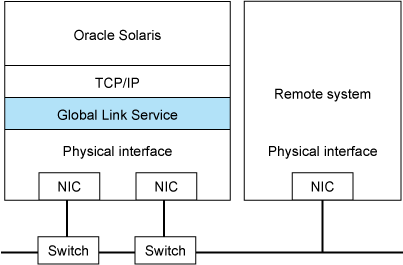The redundant line control function of Global Link Services (hereinafter GLS) provides a high-reliability communication infrastructure that supports continuous transmission in the event of a network path or card failure by making transmission routes redundant with multiple NIC (Network Interface Cards). GLS enables the following four network control methods:
Fast switching mode
NIC switching mode
GS/SURE linkage mode
Virtual NIC mode
This section describes the virtual NIC mode. For other modes, see "PRIMECLUSTER Global Link Services Configuration and Administration Guide Redundant Line Control Function."
Virtual NIC mode
Virtual NIC mode provides a high-reliability communication by grouping multiple network interfaces on the same network as one virtual interface. If one transmission route fails, ongoing communications will be switched to the other transmission route. There are no restrictions on remote systems to communicate with. When comparing the virtual NIC mode to the NIC switching mode which makes network interfaces on the same network redundant, there are the following features:
Specifying IP addresses to be monitored is unnecessary by the fault monitoring function
In Solaris Zones environments, the virtual NIC is available from not only a global zone but also a non-global zone
In Oracle VM environments, the configuration where virtual interfaces connect to virtual switches is available
Figure 1.1 Virtual NIC mode
